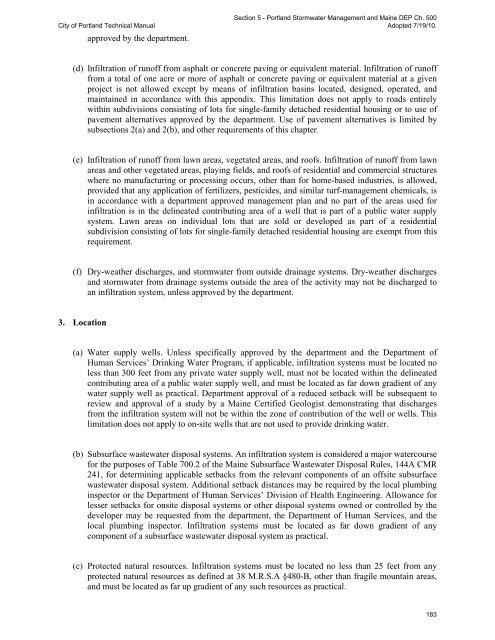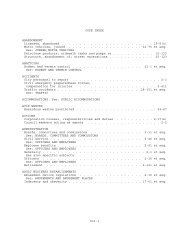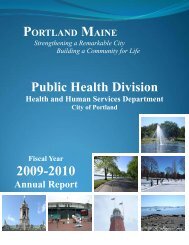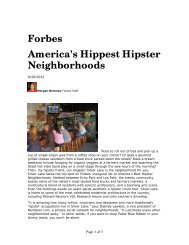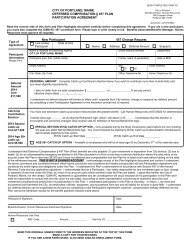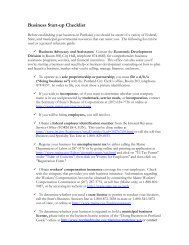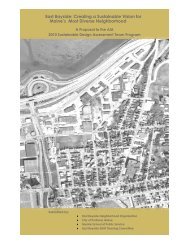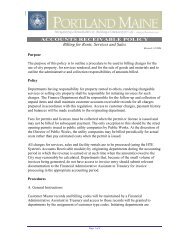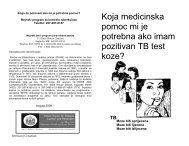City of Portland Technical Manual
City of Portland Technical Manual
City of Portland Technical Manual
Create successful ePaper yourself
Turn your PDF publications into a flip-book with our unique Google optimized e-Paper software.
<strong>City</strong> <strong>of</strong> <strong>Portland</strong> <strong>Technical</strong> <strong>Manual</strong><br />
approved by the department.<br />
Section 5 - <strong>Portland</strong> Stormwater Management and Maine DEP Ch. 500<br />
Adopted 7/19/10.<br />
(d) Infiltration <strong>of</strong> run<strong>of</strong>f from asphalt or concrete paving or equivalent material. Infiltration <strong>of</strong> run<strong>of</strong>f<br />
from a total <strong>of</strong> one acre or more <strong>of</strong> asphalt or concrete paving or equivalent material at a given<br />
project is not allowed except by means <strong>of</strong> infiltration basins located, designed, operated, and<br />
maintained in accordance with this appendix. This limitation does not apply to roads entirely<br />
within subdivisions consisting <strong>of</strong> lots for single-family detached residential housing or to use <strong>of</strong><br />
pavement alternatives approved by the department. Use <strong>of</strong> pavement alternatives is limited by<br />
subsections 2(a) and 2(b), and other requirements <strong>of</strong> this chapter.<br />
(e) Infiltration <strong>of</strong> run<strong>of</strong>f from lawn areas, vegetated areas, and ro<strong>of</strong>s. Infiltration <strong>of</strong> run<strong>of</strong>f from lawn<br />
areas and other vegetated areas, playing fields, and ro<strong>of</strong>s <strong>of</strong> residential and commercial structures<br />
where no manufacturing or processing occurs, other than for home-based industries, is allowed,<br />
provided that any application <strong>of</strong> fertilizers, pesticides, and similar turf-management chemicals, is<br />
in accordance with a department approved management plan and no part <strong>of</strong> the areas used for<br />
infiltration is in the delineated contributing area <strong>of</strong> a well that is part <strong>of</strong> a public water supply<br />
system. Lawn areas on individual lots that are sold or developed as part <strong>of</strong> a residential<br />
subdivision consisting <strong>of</strong> lots for single-family detached residential housing are exempt from this<br />
requirement.<br />
(f) Dry-weather discharges, and stormwater from outside drainage systems. Dry-weather discharges<br />
and stormwater from drainage systems outside the area <strong>of</strong> the activity may not be discharged to<br />
an infiltration system, unless approved by the department.<br />
3. Location<br />
(a) Water supply wells. Unless specifically approved by the department and the Department <strong>of</strong><br />
Human Services’ Drinking Water Program, if applicable, infiltration systems must be located no<br />
less than 300 feet from any private water supply well, must not be located within the delineated<br />
contributing area <strong>of</strong> a public water supply well, and must be located as far down gradient <strong>of</strong> any<br />
water supply well as practical. Department approval <strong>of</strong> a reduced setback will be subsequent to<br />
review and approval <strong>of</strong> a study by a Maine Certified Geologist demonstrating that discharges<br />
from the infiltration system will not be within the zone <strong>of</strong> contribution <strong>of</strong> the well or wells. This<br />
limitation does not apply to on-site wells that are not used to provide drinking water.<br />
(b) Subsurface wastewater disposal systems. An infiltration system is considered a major watercourse<br />
for the purposes <strong>of</strong> Table 700.2 <strong>of</strong> the Maine Subsurface Wastewater Disposal Rules, 144A CMR<br />
241, for determining applicable setbacks from the relevant components <strong>of</strong> an <strong>of</strong>fsite subsurface<br />
wastewater disposal system. Additional setback distances may be required by the local plumbing<br />
inspector or the Department <strong>of</strong> Human Services’ Division <strong>of</strong> Health Engineering. Allowance for<br />
lesser setbacks for onsite disposal systems or other disposal systems owned or controlled by the<br />
developer may be requested from the department, the Department <strong>of</strong> Human Services, and the<br />
local plumbing inspector. Infiltration systems must be located as far down gradient <strong>of</strong> any<br />
component <strong>of</strong> a subsurface wastewater disposal system as practical.<br />
(c) Protected natural resources. Infiltration systems must be located no less than 25 feet from any<br />
protected natural resources as defined at 38 M.R.S.A §480-B, other than fragile mountain areas,<br />
and must be located as far up gradient <strong>of</strong> any such resources as practical.<br />
183


